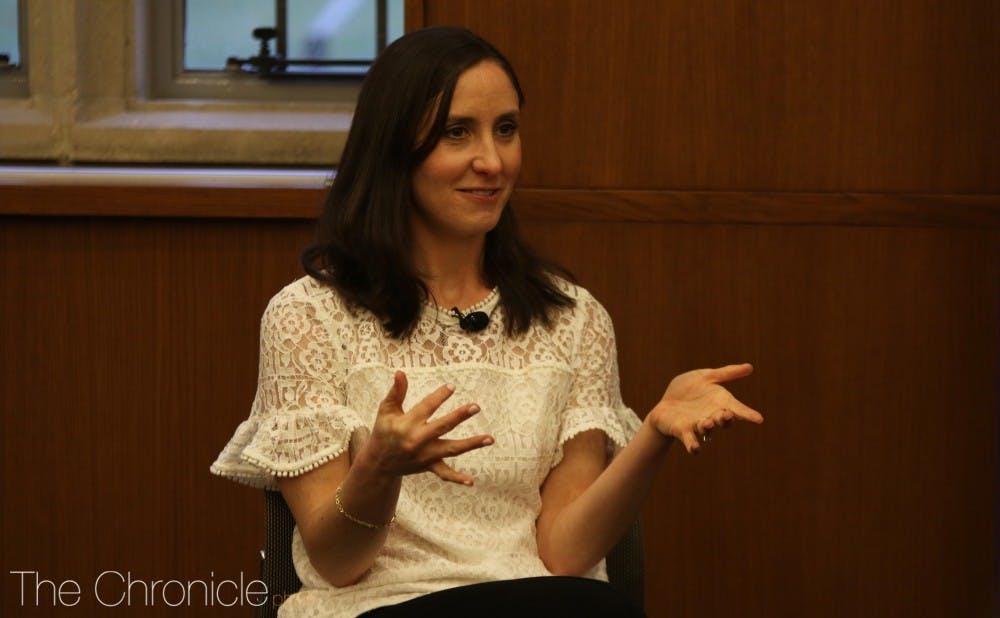New York Times business reporter Emily Steel spoke Monday night about her role in the Times' exposure of sexual harassment at Fox News.
The talk, part of the James D. Ewing Lectures on Ethics in Journalism series, was moderated by Bill Adair, Knight professor of the practice of journalism and public policy. Steel detailed her efforts to secure sources and uncover stories helped lead to the firing of Fox News' two most prominent figures.
At the start of the lecture, Adair reminded the audience that the following conversation not only embodied the important #metoo moment but also represented the responsibility of journalists to hold others accountable.
Steel began by saying that she knew she wanted to be a journalist when she was 8 years old, after her mother took her to the local television station on "take your daughter to work today." Steel quickly abandoned her dream of becoming a meteorologist in favor of becoming a journalist because journalists were the ones with the “the cool jobs.”
Since then, she’s been hooked on finding the truth.
“Every day when I walk into the newsroom, I feel this energy and this lifeblood of people asking questions and writing stories,” Steel said.
Steel started at the Times in the summer of 2014. In the summer of 2016, she got her big break after Fox News Gretchen Carlson accused Roger Ailes—then the CEO of the network—of sexual harassment. Steel began to investigate whether sexual harassment was just an issue with Roger Ailes or, if it was a problem across the entire network. She quickly realized it was the latter.
“I found that their were interns who had inappropriate relations with their superiors, were consistently receiving unwelcome inappropriate comments in the newsroom and were given conditioned assignments based on sexual favors,” Steel said.
Ailes eventually resigned amid the harassment allegations. But Steel kept digging and zeroed in on Bill O' Reilly, another prominent Fox News host.
She found a pattern of women who had been sexually harassed by O'Reailly that started in the early 2000s and ended in January 2017. The reason nobody had heard about these women? One word: settlements.
“Settlements for so long had been used to silence women, but we saw that if we could get people to admit settlements had been made, the world would know that Fox knew what had been going on,” Steel said.
While Steel said it was challenging to get women to open up to her about such a taboo topic, Steel was persistent. She sent victims emails, made phone calls and even wrote handwritten notes to them. Eventually, the women opened up and Steel reported on O' Reilly's pattern.
She learned that he tended to strike up a relationship with a woman in the newsroom, offer her career advice and shortly after, she would appear on his show as a guest. After the guest appearance, however, the woman would fall victim to O' Reilly’s inappropriate behavior.
The women feared that if they told anyone about what had happened to them, their careers would be derailed—and they were right. Those women who spoke up never worked in television news again and were silenced by settlements.
Wendy Walsh was the only woman who went on the record for Steel’s story since she never had a settlement to silence her. Walsh had been a regular guest on O’ Reilly’s show and when O' Reilly invited her to dinner, she was hoping it would entail career advice which could land her a more lucrative position at Fox.
O' Reilly didn’t just give her advice—he promised Walsh a job. However, when dinner was over and Walsh turned down O' Reilly’s request that they go back to her room, he began insulting her. Shortly after, Walsh was kicked off his show.
After going to California and signing up for the same pilates class as Walsh just to be able to speak to her, Steel got Walsh on the record. Steel started reporting on this story in August 2016. In April 2017, the story was finally published.
“When the story hit, there was just a huge outcry…women in the company were furious, saying how could Fox continue to employ this man when they knew these allegations had been made,” Steel said.
Once the story was out there, people on social media began railing against ads that appeared on O’ Reilly’s show and the hashtag #DropO'Reilly flooded social media. Steel said continued social media coverage is what got The Times to continue reporting on the topic.
Get The Chronicle straight to your inbox
Sign up for our weekly newsletter. Cancel at any time.

